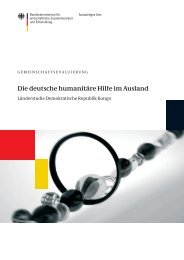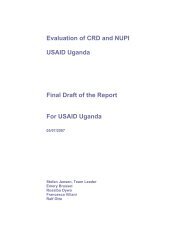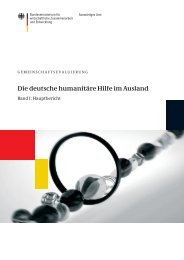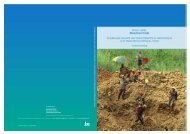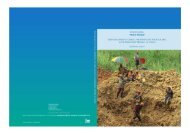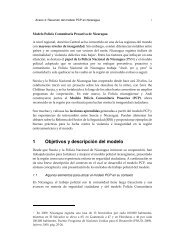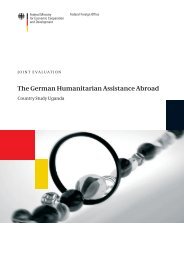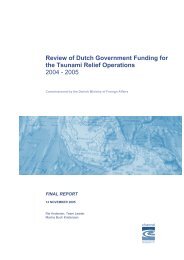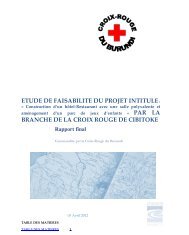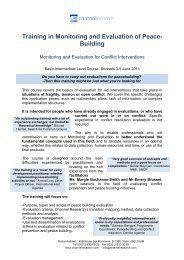A ripple in development? - Channel Research
A ripple in development? - Channel Research
A ripple in development? - Channel Research
Create successful ePaper yourself
Turn your PDF publications into a flip-book with our unique Google optimized e-Paper software.
ilitation and <strong>development</strong> (L<strong>in</strong>k<strong>in</strong>g Relief Rehabilitation and Development<br />
or LRRD). We shed light on this issue by ask<strong>in</strong>g how have the<br />
populations been impacted by the recovery efforts? And how much of<br />
that can be traced back to the manner <strong>in</strong> which the various <strong>in</strong>itiatives<br />
came together <strong>in</strong> a well coord<strong>in</strong>ated and cohesive manner?<br />
The strength of the LRRD concept lies <strong>in</strong> the breadth and range<br />
of what it can cover: all those agencies and organisations which have<br />
had an <strong>in</strong>fluence on the lives of the affected populations are considered<br />
to be part of this evaluation. At the same time it is abstract, as the aim<br />
is not to evaluate any s<strong>in</strong>gle action or <strong>in</strong>itiative (for example a dedicated<br />
trust fund or an NGO project) but to evaluate the comb<strong>in</strong>ed impact of<br />
the different <strong>in</strong>terventions which formed the overall recovery effort. The<br />
notion of LRRD <strong>in</strong> fact forms an <strong>in</strong>tr<strong>in</strong>sic part of current efforts with<strong>in</strong><br />
the <strong>in</strong>ternational humanitarian community to improve the quality of<br />
risk reduction, emergency assistance, and <strong>development</strong> cooperation.<br />
From October 2005 to May 2006, four <strong>in</strong>dependent teams worked<br />
with<strong>in</strong> the Tsunami Evaluation Coalition (TEC) to evaluate the LRRD<br />
dimensions of the <strong>in</strong>ternational response to the tsunami <strong>in</strong> Indonesia<br />
and Sri Lanka. The reports were made public and contributed to the<br />
overall TEC synthesis f<strong>in</strong>d<strong>in</strong>gs, which have been widely published.<br />
Sida (Swedish International Development Cooperation Agency),<br />
jo<strong>in</strong>tly with resources from the Governments of Sri Lanka, Indonesia,<br />
Netherlands, Norway, and Denmark, and with the participation of a<br />
broader group of academics and organisations that make up the Jo<strong>in</strong>t<br />
Steer<strong>in</strong>g Committee, commissioned <strong>Channel</strong> <strong>Research</strong> and three partners:<br />
Dara, AIDMI, and TeamC Voter, to carry out this follow-up evaluation<br />
of the previous Tsunami Evaluation on the L<strong>in</strong>kages between<br />
Relief, Rehabilitation and Development activities. As a period of four<br />
years has elapsed, the l<strong>in</strong>k to <strong>development</strong> activities, and the quality of<br />
l<strong>in</strong>kages, is much more apparent than it was <strong>in</strong> 2005, hence justify<strong>in</strong>g<br />
this second phase.<br />
The first evaluation contributed to the overall TEC conclusions<br />
about <strong>in</strong>ternational efforts. It was designed to look at the effect of a<br />
s<strong>in</strong>gle sudden onset disaster, a tidal wave of exceptional proportions, on<br />
the very different liv<strong>in</strong>g conditions and recovery processes <strong>in</strong> Sri Lanka<br />
and Indonesia. The present evaluation takes place exactly three years<br />
after the first, and concerns the same two countries over the <strong>in</strong>terven<strong>in</strong>g<br />
period, and also the Maldives.<br />
Our f<strong>in</strong>d<strong>in</strong>gs are <strong>in</strong>tended to contribute to the <strong>development</strong> of<br />
good practices for all actors, <strong>in</strong>clud<strong>in</strong>g national authorities and local<br />
associations. Our assessment is based on previous documented analyses,<br />
as well as on our own data collection <strong>in</strong> the affected countries, throw<strong>in</strong>g<br />
light on plann<strong>in</strong>g and operations by a multitude of agencies (government,<br />
<strong>in</strong>ternational and non-governmental, and the commercial sector).<br />
18



